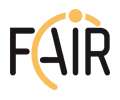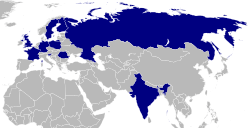Facility for Antiproton and Ion Research
 | |
 | |
| Abbreviation | FAIR |
|---|---|
| Formation | 2010 |
| Location | |
Chairman/Scientific Managing Director | Boris Sharkov |
Administrative Managing Director | Ursula Weyrich |
Director Site and Buildings | Thomas Burkhard (ad interim) |
Technical Director | Joerg Blaurock |
| Website | fair-center.eu |
The Facility for Antiproton and Ion Research (FAIR)[1] is an international accelerator facility under construction which will use antiprotons and ions to perform research in the fields of: nuclear, hadron and particle physics, atomic and anti-matter physics, high density plasma physics, and applications in condensed matter physics, biology and the bio-medical sciences. It is situated in Darmstadt in Germany and is expected to provide beams to the experiments from 2018 onwards.
FAIR will be based upon an expansion of the GSI Helmholtz Centre for Heavy Ion Research, the details of which have been laid out in the FAIR Baseline Technical Report 2006.[2] On October 4, 2010 the Facility for Antiproton and Ion Research in Europe limited liability company (German GmbH), abbreviated as FAIR GmbH, was founded which coordinates the construction of the new accelerators and experiments.
The project's cost was estimated at 1.6-billion-euro ($2 billion).[3]
FAIR science case
The four scientific pillars of FAIR are:
- Atomic, Plasma Physics and Applications - APPA,[4]
- Compressed Baryonic Matter - CBM,[5]
- Nuclear Structure, Astrophysics and Reactions - NUSTAR,[6]
- antiProton ANnihilation at DArmstadt - PANDA.[7]
Those are described on the web pages of FAIR (see [8] and links therein).
FAIR accelerators

Beams of protons will be prepared in the proton linear accelerator, p-LINAC, while heavy ions will be prepared in the UNILAC. Both of them will be fed into the SIS18. From there they will be directed into SIS100 (and SIS300 if applicable). Protons will be used either to produce antiproton beams by directing them on a dedicated production target or directly used for experiments within APPA. These antiprotons will be captured and cooled in the Collector Ring, CR (and RESR when available) before being injected into HESR, where they will be utilised within the PANDA experiment. High energetic heavy ions will either be used directly for studies with the CBM or APPA experiments or to produce unstable ion beams. The latter will be produced in the Rare Isotope Production Target and filtered the Super-FRS, where the NUSTAR experiments will take place.
FAIR partner countries
Roughly 3,000 scientists from more than 50 countries are already working on the planning of the experiment and accelerator facilities. This project is realised by partners from Finland, France, Germany, India, Poland, Romania, Russia, Slovenia and Sweden that have signed an international treaty, the FAIR Convention, which formally entered into force in March 2014. The UK has joined as first associate member.[9] Further countries, like Italy, are in negotiations.
![]()
![]()
![]()
![]()
![]()
![]()
![]()
![]()
![]()
![]()
See also
Notes
- ↑ "FAIR home page". Retrieved 12 February 2013.
- ↑ FAIR - Baseline Technical Report. 2006. ISBN 3-9811298-0-6.
- ↑ "FAIR: New German particle accelerator clears first hurdle". phys.org. Retrieved 16 March 2013.
- ↑ "APPA summary". Retrieved 12 February 2013.
- ↑ CBM Collaboration. "CBM home page". Retrieved 12 February 2013.
- ↑ NUSTAR Collaboration. "NUSTAR home page". Retrieved 12 February 2013.
- ↑ PANDA Collaboration. "PANDA home page". Retrieved 12 February 2013.
- ↑ "Planned experiments at FAIR". FAIR. Retrieved 12 Feb 2013.
- ↑ "Britain signs up to world's hottest nuclear physics project". Guardian. 3 May 2013. Retrieved 13 May 2013.
External links
- Facility for Antiproton and Ion Research in Europe GmbH: FAIR Home
- Public information
- Planned experiments at FAIR
Coordinates: 49°55′53″N 8°40′45″E / 49.93139°N 8.67917°E